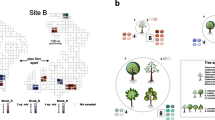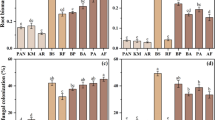Abstract
Aims
Ecological forest succession can be influenced by plant-plant interactions that exert contrasting effects on early- and late-successional species. In this study, we explored the role of indirect plant-plant interactions and the underlying microbial mechanisms in forest succession.
Methods
In a mesocosm experiment, we used Schima superba, a widespread mid-successional species in subtropical China, as a model species to explore how inoculating the rhizosphere soil of Schima affected the performances of two early-successional species (Pinus massoniana and Rhodomyrtus tomentosa) and two late-successional species (Cryptocarya chinensis and Machilus chinensis). All direct and indirect correlations between plant performance and soil microbial composition were examined using partial least square path models.
Results
Schima inoculum inhibited the growth of the early-successional species but had little effect on the growth of the late-successional species. Inoculation reduced non-arbuscular mycorrhizal fungi (non-AMF) colonization in both species groups but increased arbuscular mycorrhizal fungi (AMF) colonization in the late-successional species. The percentage of root lesions in the early-successional species increased with inoculation, while that in the late-successional species decreased. Plant nutrient acquisition was not responsive to inoculation. According to the path models, soil microbes explained 51% of the growth variances in the early-successional species but barely explained any growth variances in the late species.
Conclusions
Schima may increase the competitive advantage of the late-successional species over early-successional species by inhibiting the mutualistic association between non-AMF and the latter, which in turn may facilitate forest succession.




Similar content being viewed by others
References
Allen EB, Allen MF, Helm DJ, Trappe JM, Molina R, Rincon E (1995) Patterns and regulation of mycorrhizal plant and fungal diversity. Plant Soil 170:47–62
Barberan A, McGuire KL, Wolf JA, Jones FA, Wright SJ, Turner BL et al (2015) Relating belowground microbial composition to the taxonomic, phylogenetic, and functional trait distributions of trees in a tropical forest. Ecol Lett 18:1397–1405
Bardgett RD, Shine A (1999) Linkages between plant litter diversity, soil microbial biomass and ecosystem function in temperate grasslands. Soil Biol Biochem 31:317–321
Bardgett RD, Streeter TC, Bol R (2003) Soil microbes compete effectively with plants for organic-nitrogen inputs to temperate grasslands. Ecology 84:1277–1287
Bates D, Maechler M, Bolker B, Walker S (2015) Fitting linear mixed-effects models using lme4. J Stat Softw 67:1–48
Bennett JA, Maherali HR, Reinhart KO, Lekberg Y, Hart MM, Klironomos J (2017) Plant-soil feedbacks and mycorrhizal type influence temperate forest population dynamics. Science 355:181–184
Bever JD (2003) Soil community feedback and the coexistence of competitors: conceptual frameworks and empirical tests. New Phytol 157:465–473
Bossio DA, Scow KM (1998) Impacts of carbon and flooding on soil microbial communities: phospholipid fatty acid profiles and substrate utilization patterns. Microb Ecol 35:265–278
Brockett BFT, Prescott CE, Grayston SJ (2012) Soil moisture is the major factor influencing microbial community structure and enzyme activities across seven biogeoclimatic zones in western Canada. Soil Biol Biochem 44:9–20
Brundrett M, Bougher N, Dell B, Grove T, Malajczuk N (1996) Working with mycorrhizas in forestry and agriculture. AClAR Monograph, Australia
Cao H (2013) Dinghushan lower subtropical forest dynamics plot: tree species and their distribution pattern. China Forestry Publishing House, Beijing, China
Carrillo-Garcia A, de la Luz JLL, Bashan Y, Bethlenfalvay GJ (1999) Nurse plants, mycorrhizae, and plant establishment in a disturbed area of the Sonoran Desert. Restor Ecol 7:321–335
Chen L, Zheng Y, Gao C, Mi XC, Ma KP, Wubet T, Guo L (2017) Phylogenetic relatedness explains highly interconnected and nested symbiotic networks of woody plants and arbuscular mycorrhizal fungi in a Chinese subtropical forest. Mol Ecol 26:2563–2575
Connell JH, Slatyer RO (1977) Mechanisms of succession in natural communities and their role in community stability and organization. Am Nat 111:1119–1144
Cornelissen JHC, Werger MJA, Zhong Z (1994) Effects of canopy gaps on the growth of tree seedlings from subtropical broad-leaved evergreen forests of southern China. Vegetatio 110:43–54
Gelman A, Hill J (2006) Data analysis using regression and multilevel/hierarchical models. Cambridge University Press, New York
Grau HR, Arturi MF, Brown AD, Acenolaza PG (1997) Floristic and structural patterns along a chronosequence of secondary forest succession in Argentinean subtropical montane forests. For Ecol Manag 95:161–171
Gupta R, Krishnamurthy KV (1996) Response of mycorrhizal and nonmycorrhizal Arachis hypogaea to NaCl and acid stress. Mycorrhiza 6:145–149
Hoffmann WA, Poorter H (2002) Avoiding bias in calculations of relative growth rate. Ann Bot 90:37–42
Hothorn T, Bretz F, Westfall P (2008) Simultaneous inference in general parametric models. Biom J 50:346–363
Howard K, Dell B, Hardy GE (2000) Phosphite and mycorrhizal formation in seedlings of three Australian Myrtaceae. J Bot 48:725–729
Huang W, Liu J, Wang YP, Zhou G, Han T, Li Y (2013) Increasing phosphorus limitation along three successional forests in southern China. Plant Soil 364:181–191
Huang J, Nara K, Zong K, Wang J, Xue S, Peng K et al (2014) Ectomycorrhizal fungal communities associated with masson pine (Pinus massoniana) and white oak (Quercus fabri) in a manganese mining region in Hunan Province. China. Fungal Ecol 9:1–10
Kardol P, Bezemer TM, van der Putten WH (2006) Temporal variation in plant-soil feedback controls succession. Ecol Lett 9:1080–1088
Kardol P, Cornips NJ, van Kempen MML, Bakx-Schotman JMT, van der Putten WH (2007) Microbe-mediated plant-soil feedback causes historical contingency effects in plant community assembly. Ecol Monogr 77:147–162
Kilpeläinen J, Vestberg M, Repo T, Lehto T (2016) Arbuscular and ectomycorrhizal root colonisation and plant nutrition in soils exposed to freezing temperatures. Soil Biol Biochem 99:85–93
Klironomos JN (2002) Feedback with soil biota contributes to plant rarity and invasiveness in communities. Nature 417:67–70
Krüger C, Kohout P, Janoušková M, Püschel D, Frouz J, Rydlová J (2017) Plant communities rather than soil properties structure arbuscular mycorrhizal fungal communities along primary succession on a mine spoil. Front Microbiol 8:719
Landeweert R, Hoffland E, Finlay RD, Kuyper TW, van Breemen N (2001) Linking plants to rocks: ectomycorrhizal fungi mobilize nutrients from minerals. Trends Ecol Evol 16:248–254
Lankau RA (2013) Species invasion alters local adaptation to soil communities in a native plant. Ecology 94:32–40
Li D, Waller D (2016) Long-term shifts in the patterns and underlying processes of plant associations in Wisconsin forests. Glob Ecol Biogeogr 25:516–526
Li X, Wheeler GS, Ding J (2012) A leaf-rolling weevil benefits from general saprophytic fungi in polysaccharide degradation. Arthropod Plant Interact 6:417–424
Liang M, Liu X, Etienne RS, Huang F, Wang Y, Yu S (2015) Arbuscular mycorrhizal fungi counteract the janzen-connell effect of soil pathogens. Ecology 96:562–574
Liu L, Gundersen P, Zhang T, Mo J (2012a) Effects of phosphorus addition on soil microbial biomass and community composition in three forest types in tropical China. Soil Biol Biochem 44:31–38
Liu X, Liang M, Etienne RS, Wang Y, Staehelin C, Yu S (2012b) Experimental evidence for a phylogenetic Janzen-Connell effect in a subtropical forest. Ecol Lett 15:111–118
Lu R (1999) Agricultural chemical analysis of the soil. China Agricultural Science and Technology Press, Beijing
Maggi E, Bertocci I, Vaselli S, Benedetti-Cecchi L (2011) Connell and slatyer's models of succession in the biodiversity era. Ecology 92:1399–1406
Mangan SA, Schnitzer SA, Herre EA, Mack KML, Valencia MC, Sanchez EI et al (2010) Negative plant-soil feedback predicts tree-species relative abundance in a tropical forest. Nature 466:752–U10
Männistö MK, Tiirola M, Häggblom MM (2009) Effect of freeze-thaw cycles on bacterial communities of arctic tundra soil. Microb Ecol 58:621–631
Marcoulides GA, Saunders C (2006) Editor's comments: PLS: a silver bullet? Manag Inf Syst Q 30:iii–iix
Maschinski J, Whitham TG (1989) The continuum of plant responses to herbivory: the influence of plant association, nutrient availability, and timing. Am Nat 134:1–19
Mccarthy-Neumann S, Kobe RK (2008) Tolerance of soil pathogens co-varies with shade tolerance across species of tropical tree seedlings. Ecology 89:1883–1892
Mcgonigle TP, Miller MH, Evans DG, Fairchild GL, Swan JA (1990) A new method which gives an objective measure of colonization of roots by vesicular-arbuscular mycorrhizal fungi. New Phytol 115:495–501
Metlen KL, Aschehoug ET, Callaway RM (2013) Competitive outcomes between two exotic invaders are modified by direct and indirect effects of a native conifer. Oikos 122:632–640
Mo J, Brown S, Xue J, Fang Y, Li Z (2006) Response of litter decomposition to simulated N deposition in disturbed, rehabilitated and mature forests in subtropical China. Plant Soil 282:135–151
Moosavi MR, Zare R (2012) Fungi as biological control agents of plant-parasitic nematodes. Springer Netherlands, Dordrecht
Nakano-Hylander A, Olsson PA (2007) Carbon allocation in mycelia of arbuscular mycorrhizal fungi during colonisation of plant seedlings. Soil Biol Biochem 39:1450–1458
Nara K (2006) Pioneer dwarf willow may facilitate tree succession by providing late colonizers with compatible ectomycorrhizal fungi in a primary successional volcanic desert. New Phytol 171:187–198
Nara K, Hogetsu T (2004) Ectomycorrhizal fungi on established shrubs facilitate subsequent seedling establishment of successional plant species. Ecology 85:1700–1707
O’Hanlon-Manners DL, Kotanen PM (2006) Losses of seeds of temperate trees to soil fungi: effects of habitat and host ecology. Plant Ecol 187:49–58
Oksanen J, Blanchet GF, Friendly M, Kindt R, Legendre P, McGlinn D et al (2016) vegan: community ecology package. https://CRAN.R-project.org/ package=vegan
Olff H, Ritchie ME (1989) Effects of herbivores in grassland plant diversity. Trend Ecol Evol 13:261–265
Peng S, Wang B (1993) Forest succession at dinghushan, Guangdong, China. Journal of Tropical and Subtropical Botany 1:34–42
Peng S, Zhou T, Liang L, Ren W (2012) Landscape pattern dynamics and mechanisms during vegetation restoration: a multiscale, hierarchical patch dynamics approach. Restoration Ecol 20:95–102
Phillips JM, Hayman DS (1970) Improved procedures for clearing roots and staining parasitic and vesicular-arbuscular mycorrhizal fungi for rapid assessment of infection. Trans Br Mycol Soc 55:158–161
R Core Team (2017) R: a language and environment for statistical computing. Vienna, Austria: R Foundation for Statistical Computing. URL: http://www.R-project.org/
Rees M, Condit R, Crawley M, Pacala S, Tilman D (2001) Long-term studies of vegetation dynamics. Science 293:650–655
Rodríguez H, Fraga R (1999) Phosphate solubilizing bacteria and their role in plant growth promotion. Biotechnol Adv 17:319–339
Sanchez G (2013) PLS path modeling with R. Trowchez Editions, Berkeley, USA
Santiago LS, Wright SJ, Harms KE, Yavitt JB, Korine C, Garcia MN et al (2012) Tropical tree seedling growth responses to nitrogen, phosphorus and potassium addition. J Ecol 100:309–316
Schulz B, Boyle C (2005) The endophytic continuum. Mycol Res 109:661–686
Smith SE, Smith FA (2012) Fresh perspectives on the roles of arbuscular mycorrhizal fungi in plant nutrition and growth. Mycologia 104:1–13
Tilman D (1985) The resource-ratio hypothesis of plant succession. Am Nat 125:827–852
Toju H, Sato H, Tanabe AS (2014) Diversity and spatial structure of belowground plant-fungal symbiosis in a mixed subtropical forest of ectomycorrhizal and arbuscular mycorrhizal plants. PLoS One 9:e86566
Wang B, Peng S (1987) Quantitative dynamics of the dominant population in the forest communities of dinghushan. Acta Ecol Sin 7:24–31. (in Chinese with English abstract)
Wootton J (1994) The nature and consequences of indirect effcts in ecological communitites. Annu Rev Ecol Syst 25:443–466
Yan J, Li K, Peng X, Huang Z, Liu S, Zhang Q (2015) The mechanism for exclusion of Pinus massoniana during the succession in subtropical forest ecosystems: light competition or stoichiometric homoeostasis? Sci Rep 5:10994
Acknowledgements
We appreciate the help from Yaru Yuan, Meiyu Lu, Peng Zhou, Shuangbo Chen, Xiangping Tan, Chuanyin Xiang and Dingsheng Mo during soil sampling, experimental set-up and PLFA experiment. We thank Wenbo Luo and three anonymous reviewers for their thoughtful comments on the manuscript.
Funding
This project was funded by National Natural Science Foundation of China (NSFC 31700450, NSFC 31670479), Natural Science Foundation of Guangdong Province (China) (2017A03031 0386) and Fundamental Research Funds for the Central Universities (China) (17lgpy104).
Author information
Authors and Affiliations
Corresponding authors
Additional information
Responsible Editor: Felipe E. Albornoz.
Rights and permissions
About this article
Cite this article
Liao, H., Huang, F., Li, D. et al. Soil microbes regulate forest succession in a subtropical ecosystem in China: evidence from a mesocosm experiment. Plant Soil 430, 277–289 (2018). https://doi.org/10.1007/s11104-018-3733-3
Received:
Accepted:
Published:
Issue Date:
DOI: https://doi.org/10.1007/s11104-018-3733-3




